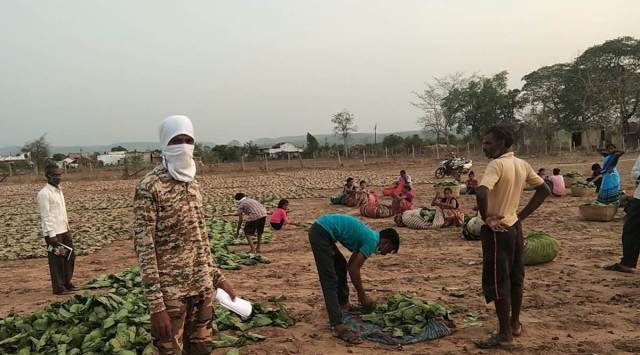- India
- International
In Chandrapur hotbed, forest officials bring down tiger threat
Chandrapur accounts for as many as 200 of Maharashtra’s 311 tigers, and hence much of its man vs animal conflict. Central Chanda is estimated to hold 25 adult tigers.
 Timings were regulated, entry registers set up for tendu collectors in Central Chanda forest area. (Express photo)
Timings were regulated, entry registers set up for tendu collectors in Central Chanda forest area. (Express photo)At a time when the rest of Maharashtra’s Chandrapur district saw 22 deaths from tiger attacks in the mahua-tendu plucking season from March to May this year, the Central Chanda divisional forest area kept the numbers down to two.
The casualties were half of those killed in this 1,112 sq km forest area that includes about 180 villages in 2019, and down from seven in 2020. Chandrapur accounts for as many as 200 of Maharashtra’s 311 tigers, and hence much of its man vs animal conflict. Central Chanda is estimated to hold 25 adult tigers.
Forest Department officials attribute the success in reducing deaths from tiger attacks in Central Chanda to a series of measures, for raising awareness among locals and avoiding accidental run-ins with the big cat. The measures included changing timings of entry of villagers into the forest area, and ensuring they went in groups and not alone.
Deputy Conservator of Forests Arvind Mundhe said: “Villagers venture into the forests in large numbers during the mahua and tendu collection season. As the yield comprises a large part of their annual income, we can’t stop them. However, they tend to be casual in terms of staying alert to the possibility of encountering carnivores, tigers in particular. Therefore, we decided to regulate their access to the forest with some sort of discipline.”
Mundhe said they held their first meeting with the villagers following the two deaths this year. “Normally, wildlife movement, particularly of tigers, is before 7 am. Villagers often entered the forest as early as 4-5 am, particularly for mahua, for which there is a competition among them to be able to pick the best of the lot. But going alone is risky. So, we allowed them to go only in groups, and that too after 8am.”

Forest officials next identified the entry points used by villagers to enter the forest and stationed staffers there with entry registers to note down their names. “The registers work as a deterrent as those trying to sneak in early know that they are under watch,” said Mundhe.
Regulating tendu collection was relatively easier as villagers mostly go into the forest for the same in groups, undertaking the task for contractors. Still, said Mundhe, “We started sending four-five of our staffers, mainly the ‘fire watchers’ (who watch out for any fires in the forest), with them to guard against possible tiger attack. The tendu contractors are bound by the terms of their contract to provide fire watchers to accompany the tendu collectors, normally comprising about 10-15 villagers. But they do not comply. They were forced to fall in line after we threatened to stop collection work,” said Mundhe.
Officials next ran an anti-snare campaign to educate villagers against setting up traps to catch small herbivores, which end up attracting tigers. “The movement of our staff near the villages had a deterrent effect on the mischief-makers,” said Mundhe.
While several parts of the mahua plant can be used for varied purposes — from flowers to extract oil to leaves for preparing biodegradable utensils — the tendu leaves are used for rolling beedis.
The tendu business fetches the Maharashtra Forest Department a royalty of Rs 100 crore every year (Rs 5-6 crore from Central Chanda), about 80% of which is passed on to the pluckers in the form of bonus given by the state government. A tendu collector gets about Rs 2,300 per standard bag of leaves collected. In a single tendu season, lasting about a month, a family can earn about Rs 10,000-15,000 for eight days of collection. With the government bonus; it adds to a substantial amount.
Mundhe said that to motivate the forest staffers, certificates for good work were provided to them. “Appreciation in writing means a lot for their career.”
Incidentally, Mundhe himself is known in the area for leading the capture of a tiger, blamed for nine deaths, after a 10-month-long hunt.
Principal Chief Conservator of Forests (Wildlife) Nitin Kakodkar said what Mundhe and his men had achieved was commendable. “Work along these lines has also been done in other divisions too but Central Chanda did it in ‘mission mode’.”
Apr 25: Latest News
- 01
- 02
- 03
- 04
- 05







































